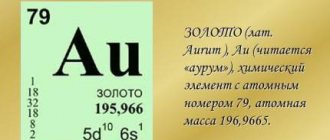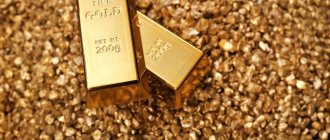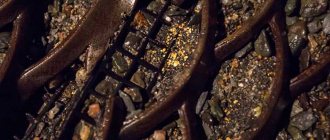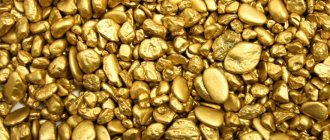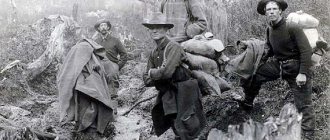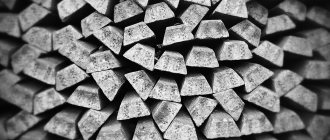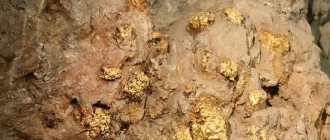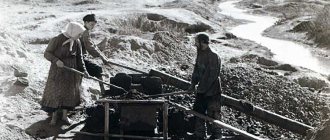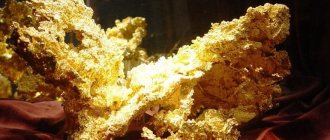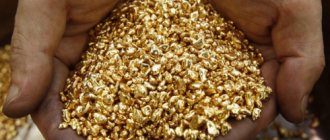Post updated: May 30, 2020
Gold is the most popular of the noble metals. Beautiful jewelry is made from gold, considerable sums are invested in gold, and gold has healing medical properties. The extraction of the yellow metal is one of the main ones in the Russian mining industry.
During its existence, humanity has mined and processed more than one hundred thousand tons of gold. About half of this stock is used in jewelry, one third is stored in state banks and one fourth is used in industrial enterprises. Amateur gold mining using artisanal methods has been going on for a very long time.
All the gold mined in human history will be a cube with an edge of 21 meters.
Several methods for extracting yellow metal
The main share of gold is mined using two methods - sand washing with a stream of water and mining in mines.
Artisanal gold mining is carried out in those places where mining has already been carried out using industrial methods and when the latter have become unprofitable, artisanal mining can give good results from the remnants of the former “luxury”. Basically, gold is mined by people from developing countries, whose financial situation pushes citizens to seek alternative income. In Africa, Asia, and South America, more than 10 million people mine gold in their free time. They take risks to help their family make ends meet. This method of gold mining is easily accessible to uninitiated people. To imagine how gold is mined independently using an artisanal method, you can watch thematic videos filmed by numerous hunters for the yellow metal.
Artisanal gold mining in Africa provides livelihoods to millions of people.
Gold deposits formed due to volcanic activity are quite important for gold mining. Such deposits lie close to the earth's surface. Among them are Khakanja in the Far East, Kuranahanskoe in Aldan and many others. Gold is also mined from pyrite-polymetallic deposits of Rudny Altai, magmatic copper-nickel deposits located in the north of the Krasnoyarsk region, and gold-bearing skarns, which are located in Olkhovka and Chibizhka at the junction of the Minusinsk Basin and the Eastern Sayan.
Primary deposits are inferior to placer deposits in many respects. THE MAIN advantage of alluvial deposits is that their development requires much less money.
These deposits are conducive to gold mining being carried out “the old fashioned way” - by hand. That is why, in the Soviet years, the state actively developed alluvial deposits, putting the indigenous ones “on the far shelf.” The decrease in the intensity of alluvial gold mining, which has been occurring in recent years, can increase the growth of unemployment in Siberia and the Far East, which could provoke an outflow of population from these parts of the country.
The technology of washing gold particles in a tray has been known for a long time.
Gold miners use the time-tested technology of washing precious metal particles in a tray. This technology has come to this day from ancient times, when washing was done using sheep skins. It happens that rains can wash gold into the river. Miners are hunting for such “consequences” of the elements.
One of the most grueling and difficult methods is digging out (presumably) gold-bearing rock with a shovel. Since in this case the coveted gold is mined only by hand, all the work consists of the following: a small amount of rock is dug out, then washed in a small tray. Heavy, unwanted metals are ground down to sand, then washed again. Then the most grueling part is the careful selection of gold particles, which is done manually.
How are gold veins found?
Gold is a mineral resource that is developed in several stages:
- Exploration of the deposit and delineation of the site for future developments.
- Economic assessment of deposit volumes.
- Excavation of deposit sites and creation of initial infrastructure for industrial development.
- Extraction of gold-bearing rocks - ore, sand and extraction of precious metal from them.
Quartz vein with gold
Exploration and prospecting work is carried out by studying rock outcrops, examining cores recovered during drilling, and geophysical studies of strata. Geologists often determine the zone of possible gold-bearing rocks by accompanying minerals. These include chalcopyrite, pyrite, sphalerite, galena, arsenopyrite, stibnite, and brown ironstone. The main mineral that geologists look for when searching for gold is quartz. It is in quartz veins that gold inclusions are most often found.
The satellites of gold ore are rocks - diorites and granites. They are formed under the same conditions in the depths as gold-bearing rocks, that is, when magma rises to the surface and cools in the upper layers of the earth's crust.
Interesting: Where do the holes in cheese come from?
Facts about artisanal mining in Russia and other countries
In many countries, including Russia, artisanal mining is illegal gold mining. In the Russian Federation, gold mining is prohibited in the absence of an agreement with gold mining companies that have a license to carry out gold mining operations. The latter is very expensive.
In contrast to Russia, in Australia and America, a license to mine the precious metal costs mere pennies – $30. Gold mining tourism is very developed, therefore all citizens have the opportunity, without fear of punishment, to arm themselves with a metal detector and look for their small “increase in salary.” Small gold miners contribute about a ton of gold per year to global production. Although such a mass is impressive, it does not affect the price of the precious metal in any way.
In Australia and America, anyone can become a prospector by purchasing an inexpensive license.
Artisanal gold mining was carried out by the ancient Greeks, who extracted it by washing gold-bearing sand on sheep skins. The essence of the method is that denser types of metals settle on the lattice when less dense ones leave it. Since gold is one of the densest materials, it is mainly retained in the lattice.
Artisanal gold mining is an extremely difficult and inefficient method. The ancient Greeks had no choice, and neither do modern miners from developing countries.
But there are also positive aspects: this technology does not involve the construction of chemical plants, expensive equipment, or high production costs for rock crushing. Rock washing is not used in dispersed gold deposits, where the size of the precious metal particles does not reach one millimeter, and in deposits where the rock is not separated from the gold after crushing.
By the end of the nineteenth century, virtually all gold was mined using the method of extraction from gold-bearing ores. This method was chosen due to the depletion of river deposits, in which less and less gold was found. Now mining is underway for ore gold, which is mined from the depths of the earth's crust and chemically separated from various foreign impurities.
Where can I find
There is very little yellow metal in the earth - if it were all scattered in an even layer in the earth's crust, then from 0.5 tons you could get only about 1 gram of pure metal. However, its deposits and areas enriched with gold are found in large quantities. The precious metal is also found in water - 1 gram of gold can be extracted from 250 tons of water.
Gold can be found in water.
Mining of the yellow metal began a very long time ago. Already in the 5th millennium BC (Neolithic era), humanity encountered this metal. Over the entire history of the planet, about 140 thousand tons of gold have been mined. Its extraction and processing can occur in various ways, but they are all based on the physical and chemical qualities of the precious metal.
Non-industrial methods for extracting precious metal from ore
There are several ways to mine gold without using industrial equipment:
- Mercury amalgamation;
- Cyanidation and flotation;
- Chlorination.
The first method involves the amalgation of sand with a gold fraction not exceeding one millimeter in size. The technology is quite simple: the metal is dissolved in mercury to form an amalgam. It is then separated from the rock by straining through a fine-mesh cloth. In the resulting alloy, gold makes up about half of the total mass. To separate it, the mercury is evaporated.
Mercury amalgamation was known and widely used in the Middle Ages.
The second method includes leaching, concentration and a purification step. The precious metal is leached due to the interaction of cyanide with oxygen, then the concentrate is removed using activated carbon, filtration and calcination.
Cyanidation allows you to obtain a purer metal than with amalgation.
The disadvantage of this method is the high danger of cyanide vapor. Cyanidation is essentially a hydrometallurgical process. In the first years of using this method, only potassium cyanide was used; later, calcium cyanide became widespread. As this type of gold mining developed, it became clear that fine grinding gives better results than the previously used coarse grinding of ores. To grind various ores, tube and ball mills are used, which operate on closed classifiers. Nowadays combined air-mechanical agitators are used.
Scheme for extracting gold from ore using cyanidation and flotation.
The third method involves the use of hydrochloric acid and chlorine, which can dissolve gold. After this, the gold is sifted out from the harder inclusions and fused into an ingot.
Types of metal
Bank gold
There are two main types of gold – bank gold and jewelry gold.
In the first option, the purity of the metal is very important, where the main standard is 999 fine. This means that such a sample does not contain impurities of other elements. Such bars are stored in state reserves and sold by banks as investments.
Strength and durability are important for jewelry gold. Therefore, pure gold is not used in jewelry because of its softness. Therefore, varieties such as yellow, white, red, pink, gray and even green gold appeared.
| Kind of gold | Additives (impurities) |
| Yellow | The most common alloy of gold + silver and copper |
| White | Alloy of gold with platinum and palladium |
| Red | Copper additive |
| Pink | Gold with the addition of copper and silver |
| Gray | Alloy of gold and steel |
| Green | Alloy of 75% gold and 25% silver with a small amount of copper |
| Black | Complex laser processing with the addition of cobalt and chromium |
Additives and percentages of all elements in jewelry gold determine its price. The amount of gold is indicated by the sample; it shows how much of the noble metal is in the product. For example, the most common 585 standard means that the product contains 58.5% pure gold, and the rest is impurities.
Recycling of radio components and gold recovery
During the Soviet era, mined metals, including precious ones, were massively used in all industries, and electronics was no exception. In Soviet-made radio and electronic devices, you can often find parts made of pure silver, platinum or gold, since they are very good electrical conductors.
How to extract precious metal from equipment?
Attention, information is for informational purposes only! This process is very dangerous, so you need to approach gold mining from radio components and similar equipment with the utmost caution and compliance with safety rules.
- First you need to remove all the parts that look like gold plated in color.
- Then prepare “regia vodka” (a mixture of nitric and hydrochloric acids) according to a special formula - this is a universal solvent that dissolves almost all organic compounds.
- The parts are placed in the solution for about 6 hours and completely dissolved. Since gold is a heavy metal, its molecules settle to the very bottom of the vessel.
- Next, you will need Hydrazine powder, which must be diluted with water and carefully poured into the aqua regia. Immediately at the bottom of the vessel, red flakes appear - this is gold.
- It needs to be collected and placed again in a new solution of hydrochloric and nitric acid.
- After passing 3 such circles, the lucky ones end up with several grams of pure gold in the form of separate threads.
- Fragments of gold are collected, melted, poured into some form and cooled.
- The output is a small gold nugget.
What does gold look like: chemical and physical properties
Gold is a noble metal, many have heard this name, but what does it mean?
Chemical properties. As a chemical element, it practically does not react and is not susceptible to the effects of aggressive substances. In short, gold does not oxidize, making it an ideal material for many industries.
Leading countries in coal production
Physical properties. What does gold look like? In its pure form, it is a rich yellow, rather soft metal, but at the same time dense, which determines the significant weight of the products.
Gold nuggets
If you take a kilogram of gold and make a ball out of it, it will be a sphere with a diameter of only 46.2 millimeters !
The pure material is very easy to process, easy to melt (melting point 1064°), forge (very thin sheet can be made) and draw.
Insignificant hardness is the main disadvantage, which is eliminated by adding impurities to the metal: silver, copper, platinum and steel. This is how different types of gold appeared.
Is it possible to mine gold in Russia?
We must not forget that illegal gold mining in Russia is considered a criminal offense and is punishable by restriction of freedom for several years. This is stated in Article 191 of the Criminal Code of the Russian Federation. The punishment can be increased to seven years by mining gold in groups.
Many scientists are convinced that the practice of the United States and Canada, where a gold mining license can be easily purchased for a small amount, would be appropriate in Russia. Connections between companies and small gold miners can significantly increase the production of the precious metal.
The consequences of the introduction of a ban on independent gold mining was that one tenth of gold production is illegal, that is, bypassing the state treasury.
History of the development of gold-bearing veins
Archaeologists suggest that gold mining as a branch of the national economy originated in the Middle East. From there, jewelry was exported to Egypt. The first finds in Sumerian tombs are more than 3 thousand years old.
One of the richest cultures in gold reserves was the ancient Inca Empire, which was located in the territory of modern Mexico, Peru and Chile. Their legacy is the mythical golden city of Eldorado, in search of which the Spanish conquistadors went.
In the 15th century, the first deposits were discovered in Mexico, Chile and Ghana. Three centuries later, the first gold mining cooperatives appeared in Russia. In 1823, the richest veins were discovered in Canada and America, which was marked by the outbreak of the famous “gold rush”. Even later, deposits were discovered in South Africa and Australia.
Artisanal Gold Mining Basics
Artisanal gold mining is based on the following principles.
The water flow supports lighter particles by weight, and acts on heavier particles in inverse proportion to their weight, depositing them on the bottom.
The forward movement of masses that are on an inclined surface and which is affected by the flow of water completely depends on the speed of the water, which is less at the bottom than at the surface. Because of this, when washing occurs, the larger diameter grains are most affected, while the smaller grains remain motionless on the bottom.
When the mixture, which is in a loosened state in the form of a semi-liquid mass, settles, smaller grains pass into the spaces between the large ones.
Types of gold deposits
Bedrock or ore deposits
Primary or ore deposit of gold
The first deposits of the precious metal are considered to be primary or ore deposits. It is from them that gold placers are formed during the destruction of strong conglomerates from rocks. Subsequently, rock fragments are transported by water flows, this explains the presence of gold in the channel valleys of small rivers. Such a placer is called alluvial and is considered the most promising for development.
Eluvial deposit
Eluvial gold deposit
An eluvial deposit is a placer of debris and sand that has not been transported. They lie where the gold-bearing rock has been destroyed; they are usually found on the watersheds of large water arteries. This type of deposit is in second place in terms of gold content.
Colluvial placer
Deluvial placer
A colluvial placer is a mass of fragments with gold-bearing inclusions that has slid down from the slopes of mountains. It is always located below the primary deposit, so before laying mines, additional exploration is carried out and the height in the mountains is found where gold-bearing strata lie. Economically, these deposits are considered low-profit.
The further fate of gold mining
Many scientists are struggling to find a new source for the precious metal because, according to some estimates, gold reserves will run out within half a century. One of the most promising methods is gold leaching.
A progressive method of mining from the bottom of the Bering Sea.
In addition to chemical methods, the development of the water element - the ocean - can help discover new deposits. Sea gold deposits are quite common, not to mention the ocean floor, about which little is known. It is likely that there, under water, there are rich reserves of the precious metal.
We also recommend that you read our article about the features of gold mining in Russia.
Gold from water
Incredible, but true: gold is contained in any water, from which it can theoretically also be extracted. In what concentration is it contained there? It turns out that it is approximately 5 kg per square km, and in sea water it is several times more than in tap water. There is also a relatively large amount of gold in melt water flowing from the mountains and in silt sediment, especially mineralized ones. It is estimated that a ton of Red Sea mud contains approximately 5 g of gold. The main way to extract it is as follows: add quicklime to water, filter out the precipitate, pour the water back into the sea or river, and subject the sediment to further processing, for example cyanidation.
Gold feeds, gold feeds, gold leads naked
The largest gold-bearing region in modern Russia is Krasnoyarsk: it is here that almost 50 tons of the precious metal are mined annually, which is 20% of total production. The region took a leading position a long time ago: back in 1851, the coat of arms of Krasnoyarsk was approved - a golden lion holding a shovel in its paws, the main tool of a prospector. Of course, the largest gold mine in Siberia gave birth to its own millionaires, and, as you know, the rich have their own quirks. So, gold miner N.F. Myasnikov ordered business cards made of pure gold: he paid five rubles for each, but with this money he could buy 16 kilograms of sturgeon caviar.
Gavrila Masharov went even further, discovering more than 100 placers, earning himself millions and the status of the richest man in Siberia.
The merchant ordered a medal with the inscription “Emperor of the entire taiga”, for which he received the nickname taiga Napoleon.
According to legend, the medal on the chain “Emperor of All Taiga” weighed more than five kilograms, so Gavrila Masharov never wore it
Gavrila did not rest on this: right in the middle of the taiga, he built himself a house, more like a palace, as befits an emperor. Glass galleries, greenhouses where pineapples were grown, rose gardens, and in a factory built nearby, real Venetian velvet was produced.
It all ended predictably and not at all rosy: Gavrila went bankrupt, went bankrupt, and creditors declared a real hunt for him. Fleeing from them, Gavrila died - most likely in a labyrinth of underground passages that he dug under his house. The location of his palace still remains a mystery, and many who are haunted by the history of the taiga Napoleon are trying to solve this mystery.
On December 3, 2010, the first season of the TV show “Gold Rush” aired on the Discovery Channel.
Gavrila’s story once again confirms the veracity of the proverb popular among gold miners: “Gold feeds, gold feeds, gold leads naked.” However, you can seize the initiative even from fate. Modern prospector Tony Beets, a Klondike legend and member of Discovery Channel's Gold Rush, is known for his experience and intuition. He does not blindly rely on luck, but prefers to create it himself, and instead of buying gold business cards and building palaces, he invests money in the development of his mine. So, he took the risk of investing a substantial amount in the restoration of a 75-year-old non-working dredge, although everyone around said that this ruin was not worth a good word. Tony calculated everything perfectly accurately: after putting the repaired machine into operation, the prospector made a profit of more than five million dollars.
